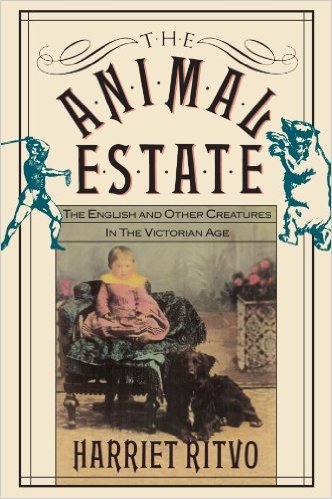
The Animal Estate: The English and other Creatures in the Victorian Age
This is a fascinating book if you’re interested in Victorian England, what Victorians thought of wild and domestic animals, and how they treated them. It’s an especially gripping story if you’re interested in the history of dogs, dog breeds, and how we got to be where we are now.
‘The Animal Estate’ is divided into three parts. Part One looks at how 'pedigree' animals became popular, both farm animals like cattle, and pets, especially dogs. If you had a pedigree dog, it was meant to show that you were different from humbler folk. The second part of the book looks at how people became interested in animal welfare, and in controlling dangerous animals, especially dogs. Legislation reflected upper class concerns about dangerous classes of human beings. Upper class folk saw brutality as characteristic of the lower classes, so cruel sports that poor people liked tended to be banned. Poor people's dogs also seemed to be more dangerous to the upper class folk who made laws. The third part of the book delves into the trend for keeping exotic animals, as pets or in zoos, and killing animals for sport in faraway places.
‘The Animal Estate’ is very much a social history of humans, so what can it tell us about dog breeds? It can tell us quite a lot, given that dog breeds are a human creation. It was in this period that dog fanciers developed the modern concept of dog breeds, the first dog shows began, and the Kennel Club was set up. This was also a time when people started thinking about abandoned dogs and their welfare, and the RSPCA was set up. We’re looking at the roots of modern dog culture.
Humans had kept dogs as pets for a long time, but it was in Victorian times that the idea of having a pet dog really took off. People who wanted to appear refined sought dogs that looked special, rather than mongrels. Some owners were even afraid they’d be looked down on as ignorant or common if they had a ‘common’ looking dog. Once dogs were no longer expected to work, they could be bred for extreme looks, even at the expense of their mobility – perhaps this sounds familiar! The notion of ‘breed’ developed in this period focused, above all, on looks, and prizes were awarded to dogs that conformed to a certain look, with endless arguments as to which colours were permitted. The first of these modern breeds came from dogs with uncertain ancestry, but the new trend meant ancestors had to be recorded.
This new approach was quite a major shift from the old view of ‘breeds’, as dogs geared to do specific jobs, without undue worry about looks or genealogy. Ritvo draws on Sydenham Edwards’ book, published at the start of the nineteenth century, which describes fifteen breeds mainly in terms of what they did, and how they behaved. Hugh Dalziel’s book, ‘British Dogs’, which came out at the end of the century, covers a very large number of breeds, focusing mainly on looks, and dog shows.
Concern for animal welfare tended to focus on cruelty involved in sports practiced by poorer people, such as bull-baiting, which was banned in 1835. At that time, bulldogs looked similar to the mastiffs of those days. The story of the bulldog is an account of how a breed type, geared to a particular job, was redesigned as a pedigree pet, with its appearance changed, to show it was no longer a common dog linked to low-life pursuits, but a special dog that would confer status on its owner. By the end of the nineteenth century, bulldogs looked pretty much as they do today, prompting one observer to comment that show bulldogs were ‘deformities from foot to muzzle’(p113).
Bulldogs are perhaps the earliest, and most dramatic example of a trend towards extreme looks through the creation of a breed uncoupled from the original working role of dogs that went by that name. Collies are another example. Show collies (later to become rough collies) were sometimes crossed with Gordon setters, for the Gordon coat. Long, pointy noses became fashionable during the 1890s. A critic complained of show collies that ‘there was no room in their heads for brains’ (p114). Some of the early critics of this trend sound very much like critics of pedigree dog fashions today.
‘The Animal Estate’ is, then very relevant to dog owners today, although it was first published in 1987. It’s a book that’s enjoyable to read from cover to cover, even if you’re mainly interested in dogs, and although it’s a serious study. There are references and notes on each chapter at the end of the book for anyone wanting to research the topics further. This is a key resource for anyone interested in dogs breeds and human-dog relationships. Keith Thomas’s ‘Man and the Natural World’, another very accessible serious classic, is a good book to read next, to explore the history of humans and other animals before the Victorian age.
Review by Alison Lever
Further Reading
Dalziel, H. (1879) British Dogs – Their Varieties, History, Characteristics, Breeding, Management and Exhibition. University of California Libraries
Edwards (S) (1800) Cynographia britanica. Gale ECCO, Print Editions (reprinted 2010)
Thomas, K. (1991) Man and the Natural World: Changing Attitudes in England 1500-1800. Penguin



